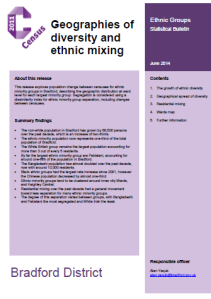 This release explores population change between censuses for ethnic minority groups in Bradford; describing the geographic distribution at ward level for each largest minority group. Segregation is considered using a dissimilarity index for ethnic minority group separation, including changes between censuses.
This release explores population change between censuses for ethnic minority groups in Bradford; describing the geographic distribution at ward level for each largest minority group. Segregation is considered using a dissimilarity index for ethnic minority group separation, including changes between censuses.
Summary findings
- The non-white population in Bradford has grown by 68,500 persons over the past decade, which is an increase of two-thirds.
- The ethnic minority population now represents one-third of the total population of Bradford.
- The White British group remains the largest population accounting for more than 3 out of every 5 residents.
- By far the largest ethnic minority group are Pakistani, accounting for around one-fifth of the population in Bradford.
- The Bangladeshi population has almost doubled over the past decade, now with around 10,000 residents.
- Black ethnic groups had the largest rate increase since 2001, however the Chinese population decreased by almost one-third.
- Ethnic minority groups tend to be clustered around inner city Wards, and Keighley Central.
- Residential mixing over the past decade had a general movement toward less separation for many ethnic minority groups.
- The degree of this separation varies between groups, with Bangladeshi and Pakistani the most segregated and White Irish the least.
To open this statistical bulletin please click here.

 This research looks at the influence of location on employment for ethnic minorities, asking why ethnic minority people fare disproportionately worse in the labour market in areas of high deprivation.
This research looks at the influence of location on employment for ethnic minorities, asking why ethnic minority people fare disproportionately worse in the labour market in areas of high deprivation. The latest Census analysis looked at changing migration patterns over 60 years.
The latest Census analysis looked at changing migration patterns over 60 years. Using recently published 2011 Census data the
Using recently published 2011 Census data the 
